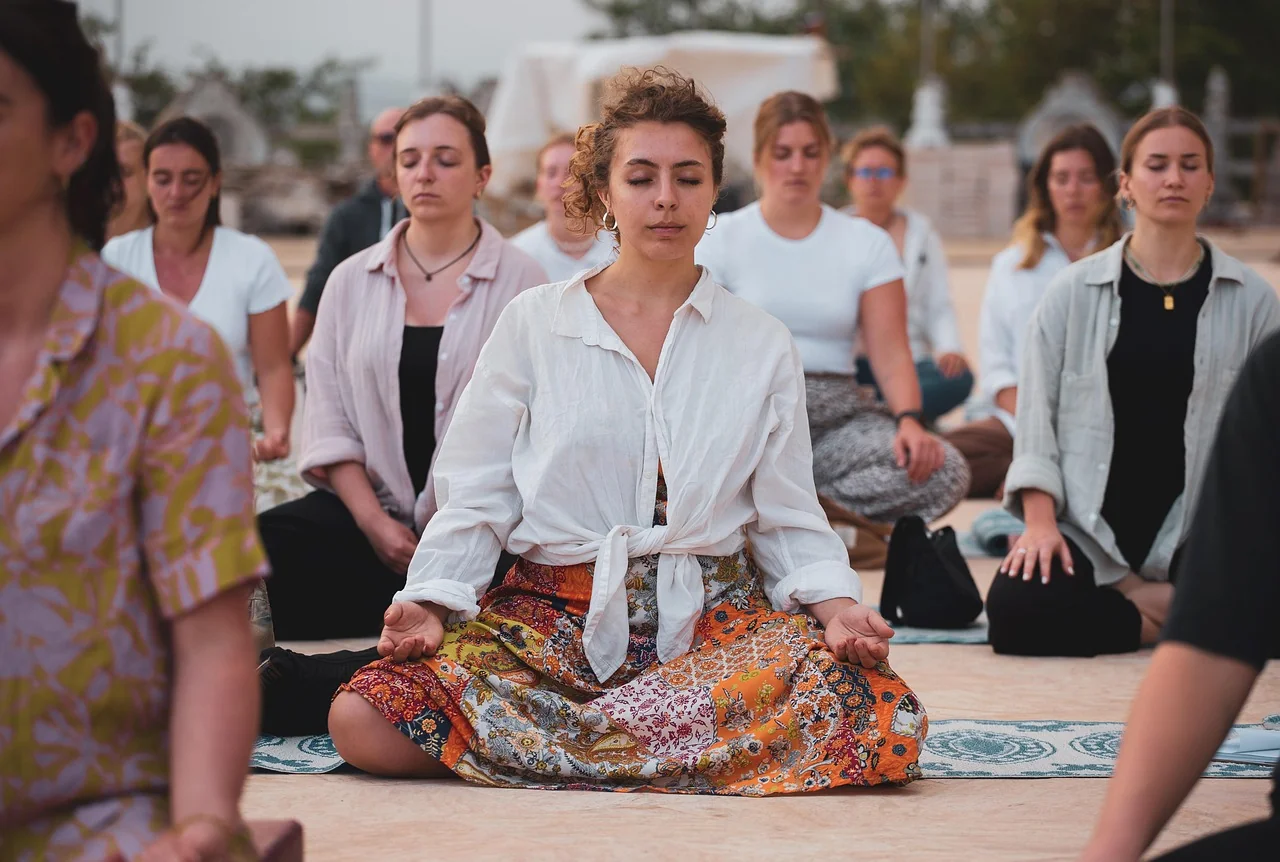Feeling overwhelmed, anxious, or just need a quick mental reset? In a world that constantly demands our attention, finding a moment of calm can feel impossible. This is where the powerful simplicity of 5 finger meditation comes in. Imagine having a discreet, always-available tool for peace right in the palm of your hand. This isn't another complicated practice requiring a silent room and 30 minutes of your day. Instead, it's a grounding technique that uses the simple act of tracing your fingers to anchor you firmly in the present moment, pulling you back from the brink of stress and anxiety.
In this complete guide, we’ll walk you through exactly how this transformative practice works. You’ll discover its surprising benefits for focus and emotional regulation, master a step-by-step guide to practice anywhere, and learn the perfect moments to deploy this portable pocket of peace throughout your day. Let's begin.
What is 5 Finger Meditation? A Beginner's Guide to Finding Calm
5 finger meditation is a grounding technique and a form of tactile mindfulness. At its core, it’s a practice that uses the physical sensation of touching each finger on one hand with the thumb of the same hand as an anchor for your attention. Each touch is synchronized with your breath, creating a simple, rhythmic pattern that pulls your focus away from racing thoughts and into the present moment.
This practice is a subset of mindfulness meditation, but its brilliance lies in its accessibility. You don’t need any equipment, apps, or special training. Your hand is a tool you always have with you, making this one of the most portable and discreet meditation methods available. It acts as a "brain hack" for moments of high stress, interrupting the cycle of anxiety by giving your mind a single, simple task to focus on. By the time you trace all five fingers, you’ve effectively hit a reset button on your nervous system.
The Surprising Benefits of a 5 Finger Meditation Practice
While it seems simple, the consistent practice of 5 finger meditation yields profound benefits for both mental and physical well-being. It’s far more than just a distraction; it’s a tool for retraining your brain’s response to stress.
Instant Anxiety & Stress Relief
When you feel stressed or anxious, your body’s sympathetic nervous system (the "fight-or-flight" response) is in overdrive. 5 finger meditation directly counters this. The combination of focused breathing and gentle, repetitive touch stimulates the vagus nerve, a key part of your parasympathetic nervous system which is responsible for "rest-and-digest" functions.
- Slows Your Heart Rate: The deliberate, slow breathing naturally lowers your heart rate.
- Lowers Blood Pressure: As your body relaxes, your blood pressure follows suit.
- Reduces Cortisol: This practice can help decrease the levels of the stress hormone cortisol in your body.
The effect is a rapid shift from a state of high alert to one of calm control, often within a single two-minute cycle.
Improved Focus and Mental Clarity
Our modern world is a minefield of distractions. 5 finger meditation is a workout for your attention muscle. The instructions are simple: breathe in, trace up a finger; breathe out, trace down. But when your mind wanders—which it will—and you notice it has drifted, the act of gently bringing your focus back to the sensation of your thumb on your finger is the entire practice.
This process of noticing distraction and returning to a single point of focus strengthens your prefrontal cortex. Over time, this makes it easier to concentrate on tasks at work or school, listen more attentively in conversations, and pull yourself out of mental fog.
Emotional Regulation in the Palm of Your Hand
Overwhelming emotions like anger, frustration, or sadness can feel all-consuming. 5 finger meditation creates a crucial "pause" between the trigger and your reaction. In that space of tracing your fingers and focusing on your breath, you give your higher brain functions a chance to catch up with your emotional limbic system.
You are not trying to suppress the emotion. Instead, you are acknowledging it while choosing a calming action. This simple act of self-regulation can prevent emotional outbursts and help you respond to situations with greater intention and wisdom.
A Powerful Grounding Technique for Panic Attacks
During a panic attack, you can feel detached from reality and overwhelmed by physical symptoms like a racing heart and shortness of breath. 5 finger meditation is an exceptionally effective grounding technique for these moments. It works by engaging multiple senses to tether you to the present.
- Touch: The physical sensation of your thumb tracing each finger.
- Sight: Watching the movement of your hand (if you choose to).
- Proprioception: The awareness of your body’s position in space.
By forcing your brain to process these concrete, present-moment sensations, it can’t simultaneously fuel the catastrophic thoughts that drive the panic. It provides a tangible lifeline back to reality.
How to Practice 5 Finger Meditation: A Step-by-Step Guide
Ready to try it? This step-by-step guide will walk you through the entire process. You can do this seated, standing, or even walking. All you need is one hand.
Find a Comfortable Position and Hold Your Hand Up. Begin by bringing yourself into the present. You can close your eyes or soften your gaze. Hold one hand up, palm facing away from you, with your fingers gently spread apart. Your other hand can rest comfortably in your lap or at your side.
Begin with Your Thumb: Tracing and Breathing. Using the index finger (or thumb) of your opposite hand, gently trace the outline of your thumb. As you trace up the outside of your thumb, take a slow, deep breath in. Pause briefly at the tip. Then, as you trace down the inside of your thumb, release a slow, complete breath out. Focus on the sensation of the touch and the rhythm of your breath.
Move to Your Index Finger: Noticing Sensations. Move your tracing finger to your index finger. Again, inhale deeply as you trace up, and exhale fully as you trace down. If your mind starts to wander to your to-do list or a worry, simply notice the thought without judgment and guide your attention back to the feeling of your finger being traced.
Continue with Your Middle, Ring, and Pinky Fingers. Continue this pattern systematically with your middle, ring, and pinky fingers. Inhale on the upward trace, exhale on the downward trace. There’s no need to rush. Spend as much time on each finger as feels natural, typically 3-5 seconds for the inhale and 3-5 seconds for the exhale.
Completing the Cycle and Noticing the Effect. Once you have traced all five fingers, you have completed one cycle. Take a final, deep breath in and out. Lower your hand. Pause for a moment to notice how you feel. Do you feel calmer? More centered? Is your breath slower or deeper? There’s no right or wrong way to feel—just observe. You can repeat the cycle on the same hand or switch to the other hand for another round.
Helpful Tips:
- If you don’t have use of both hands, you can simply use your thumb on the same hand to trace each finger without needing the other hand at all.
- If you get distracted, congratulate yourself for noticing and gently return to the finger you were on. This is the practice.
- You can enhance the practice by assigning a gratitude or affirmation to each finger as you trace it.
When to Use Your 5 Finger Meditation Technique
The power of this practice is its integration into daily life. You can use it proactively to set a calm tone for your day or reactively as a first-aid tool for stress. Here are some perfect moments to deploy it:
- Before a Stressful Meeting or Presentation: Use it for two minutes in the bathroom stall or at your desk to calm your nerves and center your thoughts.
- When Feeling Overwhelmed at Work or School: Hit a mental wall? Instead of scrolling through your phone, do a cycle of 5 finger meditation to reset your focus and reduce feelings of being overwhelmed.
- While Commuting or in a Crowded Place: On a busy train or in a crowded store, this discreet practice can create a personal bubble of calm, reducing sensory overload.
- To Quiet a Racing Mind Before Bed: If you lie down and your brain won’t shut off, practice this in bed. The rhythmic breathing and focusing can help lull your mind into a state ready for sleep.
- After a Difficult Conversation: Step away and use the technique to process your emotions and lower your arousal levels before you react or move on with your day.
- Any Time You Need a Mindful Moment: Waiting in line, on hold on the phone, or just after you wake up—these are all opportunities for a quick mental reset. If you're looking to build a consistent habit, our 5 minute daily meditation guide is a perfect next step.
Variations of the 5 Finger Practice to Explore
Once you’re comfortable with the basic technique, you can adapt it to suit different needs. These variations keep the practice fresh and can target specific challenges.
The 5-Finger Breath for Deep Calm
This is a popular variation, especially for children, but equally effective for adults. Hold one hand up, palm facing you. With the index finger of your other hand, start at the base of your thumb. As you inhale, slide your index finger up to the tip of your thumb. As you exhale, slide it down the inside. Repeat for each finger. The visual and tactile connection to the breath is very powerful for deepening relaxation.
5-Finger Gratitude Meditation
This practice shifts your focus from stress to appreciation. As you trace each finger, think of one specific thing you are grateful for. For example:
- Thumb: A person who supports you.
- Index Finger: A skill or ability you have.
- Middle Finger: Something in nature you appreciate.
- Ring Finger: A recent happy memory.
- Pinky: Something that comforts you (a warm drink, your bed).
For a deeper dive into this concept, explore our dedicated 5 minute morning gratitude meditation guide.
5-Finger Grounding for Panic and Dissociation
This is a more intense sensory grounding exercise. For each finger, you engage a different sense. As you touch your:
- Thumb: Name one thing you can see.
- Index Finger: Name one thing you can feel (the chair beneath you, your feet on the floor).
- Middle Finger: Name one thing you can hear.
- Ring Finger: Name one thing you can smell.
- Pinky: Name one thing you can taste (or a taste you like).
This powerfully forces your awareness into your immediate physical environment.
Troubleshooting Common Challenges
Starting any new practice comes with questions. Here are solutions to common hurdles.
"I can't stop my mind from wandering." This is not a sign of failure; it is the entire point of the exercise. Every time you notice your mind has wandered and you gently bring it back, you are strengthening your mindfulness muscle. It’s like a rep in a workout.
"It feels too simple to work." The simplicity is its superpower. Anxiety and stress are complex, but they thrive in a chaotic mental environment. By giving your brain one simple, repetitive, sensory-rich task, you create order from the chaos, which allows your nervous system to downshift.
"I don't have time." A single cycle takes about one to two minutes. The practice is designed for people who believe they have no time. You can find two minutes while waiting for your coffee to brew, after sending an email, or before you get out of your car. For more short, accessible practices, you can try this free 5 minute meditation for instant calm & focus.
Consistency is more important than duration. Practicing for one minute, five times a day, is far more effective than a single 30-minute session once a week. Weave it into the small moments of your day, and you will build a resilient and calm mind, one finger at a time.
In closing, the practice of five-finger meditation offers a profound yet remarkably accessible path to mindfulness. By assigning a specific worry or source of gratitude to each finger, this technique provides a tangible structure to contain and release the swirling thoughts of a busy mind. Its true power lies in its simplicity and portability, requiring no special equipment or environment, making it an ideal tool for managing stress in the midst of a hectic day. The method’s core message is clear: inner calm is not a distant goal, but a resource we can access at any moment, right at our fingertips. We encourage you to make this practice your own; experiment with the breathwork and the affirmations to discover what resonates most deeply with you. Begin with just a few minutes each day, allowing this gentle ritual to become a reliable anchor. Consistent practice can subtly rewire your response to stress, cultivating a lasting sense of grounded presence and emotional resilience. You already possess everything you need to start this transformative journey toward greater peace.


